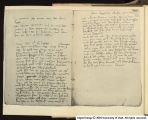| OCR Text |
Show 19 PAPERMAKIN every inch, as there are sxtcen laidlinesto every inch in the paper that the chain-line impressions are not visible in the pages, but th hair lacings, nevertheless, formed part of the construction of th original mould ‘The laced bamboo mould cover mscmblcd a piece of mattin and when a sheet of paper was to be made, the covering wa placed loosely on the shallow wooden framevwork, which supporte it firmly; the entire mould, both frame and cover, was then dippe into the vat of macerated pulp and brought to the surface loade with the wet, fibrous material. The thin paper stock was prevente from flowing beyond the top and bottom edges of the matting b bamboo rods laced to the mat at its extremities, parallel with th "laid" bamboo srips. The flow arpmp on the right and left side was kept within bound e workman, who dipped th mould, holding sticks, one in eac]o hand, along the outer cdges o the matting, parallclto the "chain" stitches. Thus the four outsid edges were fenced in such a way that the wet paper stock or pul was kept within bounds, fonmng a sheet of paper almost the si of the mould covering. Tn couching a sheet of paper the mattin was lifted free from the framework and the wet layer of paper deposited flat upon a board, the workman rolling up the matting from the top edge to the boltom, leaving the moist, tender shee firm and unwrinkled this type of mould construction seems complicated, it wa the simplest and best method that could have been devised, an upon this carly Oriental form of mould the manner of makin paper in all ages has rested, even the most modern paper-machin employs precisely the same principles. In my collection of mould for the making of paper there are specimens from China, Japan Indo-China, Burma, and all parts of India. While these mould Digital Imag © 2004 University of Utah. All rights reserved |



































































































































































































































































































































































































